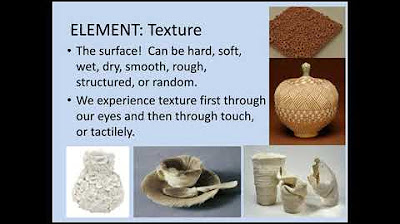Review of the Art Principles
Summary
TLDRThe video explores key art principles like contrast, unity, balance, emphasis, variety, movement, and pattern, explaining how these elements organize and create impactful artwork. Through examples, such as desert landscapes, city scenes, and famous works like Van Gogh's 'Starry Night,' the video illustrates how opposites, visual weight, color, and repeated shapes contribute to these principles. It also touches on the concept of proportion and suggests using the acronym 'CUBE VAMP' to remember the principles, making the learning process more accessible and engaging for viewers.
Takeaways
- 🎨 **Contrast**: Artwork is created by using opposites to create visual interest, such as black and white, clear versus blurry, or front versus back.
- 🔗 **Unity**: This principle is about bringing elements together cohesively, often through shared characteristics like color, shape, or overlapping objects.
- ⚖️ **Balance**: Balance can be symmetrical, where both sides mirror each other, or asymmetrical, where different elements have equal visual weight.
- 📌 **Emphasis**: This principle is used to draw attention to a particular element, making it stand out through color, size, or placement.
- 🌈 **Variety**: Introducing three or more differences in a piece adds visual interest and complexity, such as a range of colors or shapes.
- 🏃 **Movement**: Suggesting motion within a piece, either through the implied movement of elements or the way our eyes move through the artwork.
- 🔄 **Pattern**: Patterns can be regular and predictable, like bricks, or irregular and organic, like leaves, and they contribute to the rhythm of a piece.
- 🔺 **Proportion**: Sometimes discussed as an additional principle, proportion relates to the size and scale of elements within a work, influencing its overall harmony.
- 🌌 **Van Gogh's 'Starry Night'**: An example used to illustrate how multiple art principles can be seen in a single piece, including contrast, unity, balance, emphasis, variety, and pattern.
- 📝 **Acronym 'CUBE VAMP'**: A mnemonic to remember the art principles: Contrast, Unity, Balance, Emphasis, Variety, Movement, and Pattern.
Q & A
What are the art principles discussed in the script?
-The script discusses several art principles including contrast, unity, balance, emphasis, variety, movement, and pattern.
How is contrast defined in the context of art?
-Contrast in art is defined as the use of opposites to create visual interest. Examples include black and white, clear versus blurry, or front versus back.
What does unity represent in art and how can it be achieved?
-Unity in art represents a sense of cohesion or harmony within a work. It can be achieved through the use of similar colors, shapes, or by overlapping objects.
Can you explain the concept of balance in art?
-Balance in art refers to the distribution of visual weight within a composition. It can be symmetrical, where both sides are mirror images, or asymmetrical, where different elements are balanced by their visual weight.
How is emphasis used in art to draw attention?
-Emphasis in art is used to highlight or make one element stand out from the rest. This can be achieved through color, size, placement, or by drawing lines and shadows towards the emphasized element.
What is variety in art and why is it important?
-Variety in art refers to the presence of three or more differences within a composition. It adds interest and complexity, preventing the artwork from appearing monotonous.
How does movement work as an art principle?
-Movement in art can be literal, as in a blurred image suggesting motion, or implied, guiding the viewer's eye through the composition. It can also be created by the arrangement of elements leading the viewer's gaze from one part of the artwork to another.
What are the two main types of patterns discussed in the script?
-The two main types of patterns are regular and predictable patterns, like bricks, and unpredictable patterns, like leaves, which can be mechanical or organic.
What is a motif in the context of pattern in art?
-A motif in art is the smallest repeating unit within a pattern, such as individual bricks in a brick wall or leaves in a background pattern.
Why is proportion sometimes considered an art principle?
-Proportion is sometimes considered an art principle because it combines aspects of contrast and unity, and it can also refer to the relative size and scale of elements within an artwork, contributing to visual drama and harmony.
How are the art principles exemplified in Van Gogh's 'Starry Night'?
-In 'Starry Night', contrast is seen through light and dark areas, unity through the use of blue and brushstrokes, balance through asymmetrical weight distribution, emphasis on the moon or the central swirl, variety in the stars and brushstrokes, movement through the swirling sky, and pattern in the organic arrangement of stars and the town's lights.
Outlines

This section is available to paid users only. Please upgrade to access this part.
Upgrade NowMindmap

This section is available to paid users only. Please upgrade to access this part.
Upgrade NowKeywords

This section is available to paid users only. Please upgrade to access this part.
Upgrade NowHighlights

This section is available to paid users only. Please upgrade to access this part.
Upgrade NowTranscripts

This section is available to paid users only. Please upgrade to access this part.
Upgrade NowBrowse More Related Video
5.0 / 5 (0 votes)





